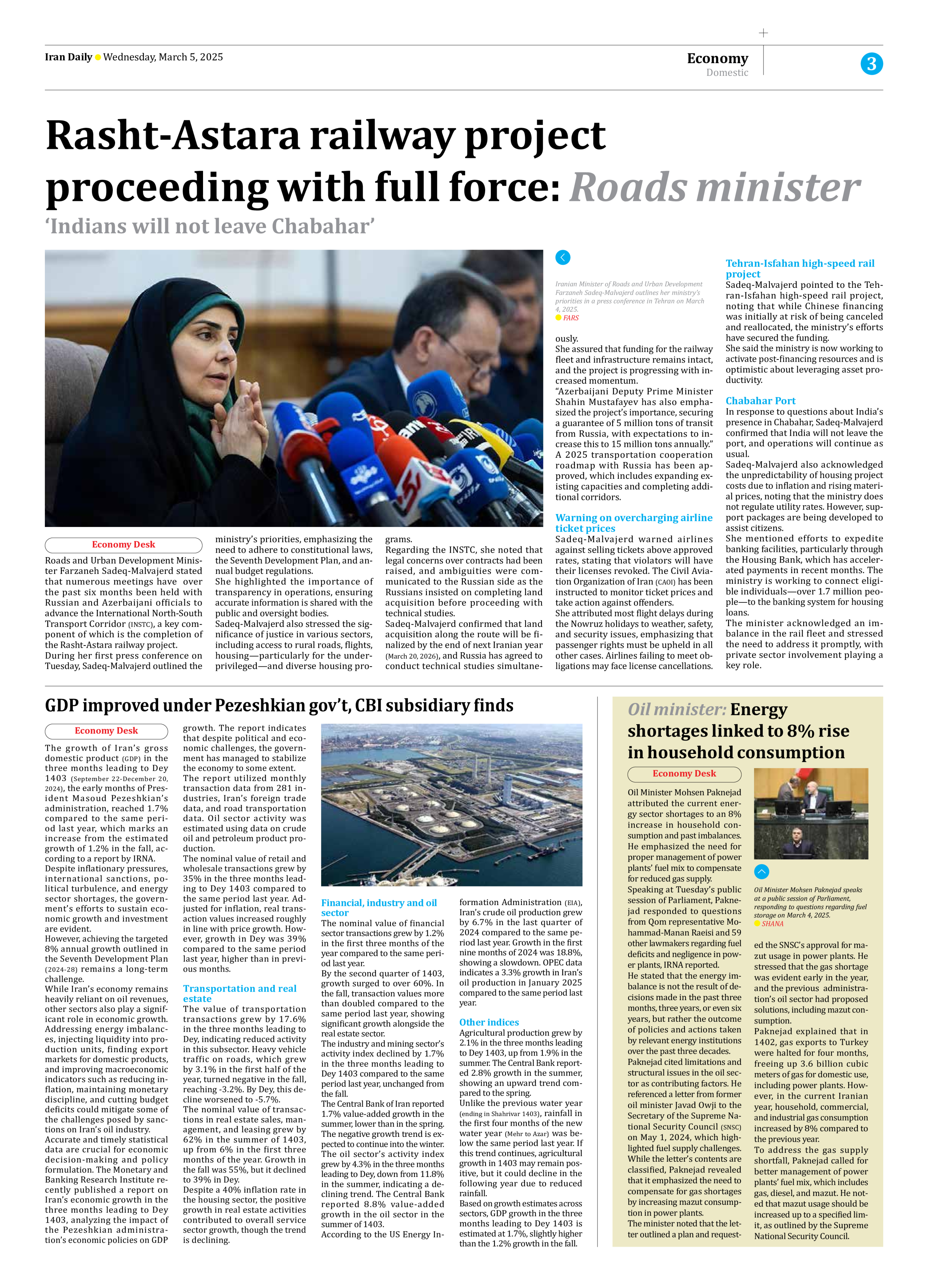
GDP improved under Pezeshkian gov’t, CBI subsidiary finds
The growth of Iran’s gross domestic product (GDP) in the three months leading to Dey 1403 (September 22-December 20, 2024), the early months of President Masoud Pezeshkian’s administration, reached 1.7% compared to the same period last year, which marks an increase from the estimated growth of 1.2% in the fall, according to a report by IRNA.
Despite inflationary pressures, international sanctions, political turbulence, and energy sector shortages, the government’s efforts to sustain economic growth and investment are evident.
However, achieving the targeted 8% annual growth outlined in the Seventh Development Plan (2024-28) remains a long-term challenge.
While Iran’s economy remains heavily reliant on oil revenues, other sectors also play a significant role in economic growth. Addressing energy imbalances, injecting liquidity into production units, finding export markets for domestic products, and improving macroeconomic indicators such as reducing inflation, maintaining monetary discipline, and cutting budget deficits could mitigate some of the challenges posed by sanctions on Iran’s oil industry.
Accurate and timely statistical data are crucial for economic decision-making and policy formulation. The Monetary and Banking Research Institute recently published a report on Iran’s economic growth in the three months leading to Dey 1403, analyzing the impact of the Pezeshkian administration’s economic policies on GDP growth. The report indicates that despite political and economic challenges, the government has managed to stabilize the economy to some extent.
The report utilized monthly transaction data from 281 industries, Iran’s foreign trade data, and road transportation data. Oil sector activity was estimated using data on crude oil and petroleum product production.
The nominal value of retail and wholesale transactions grew by 35% in the three months leading to Dey 1403 compared to the same period last year. Adjusted for inflation, real transaction values increased roughly in line with price growth. However, growth in Dey was 39% compared to the same period last year, higher than in previous months.
Transportation and real estate
The value of transportation transactions grew by 17.6% in the three months leading to Dey, indicating reduced activity in this subsector. Heavy vehicle traffic on roads, which grew by 3.1% in the first half of the year, turned negative in the fall, reaching -3.2%. By Dey, this decline worsened to -5.7%.
The nominal value of transactions in real estate sales, management, and leasing grew by 62% in the summer of 1403, up from 6% in the first three months of the year. Growth in the fall was 55%, but it declined to 39% in Dey.
Despite a 40% inflation rate in the housing sector, the positive growth in real estate activities contributed to overall service sector growth, though the trend is declining.
Financial, industry and oil sector
The nominal value of financial sector transactions grew by 1.2% in the first three months of the year compared to the same period last year.
By the second quarter of 1403, growth surged to over 60%. In the fall, transaction values more than doubled compared to the same period last year, showing significant growth alongside the real estate sector.
The industry and mining sector’s activity index declined by 1.7% in the three months leading to Dey 1403 compared to the same period last year, unchanged from the fall.
The Central Bank of Iran reported 1.7% value-added growth in the summer, lower than in the spring. The negative growth trend is expected to continue into the winter.
The oil sector’s activity index grew by 4.3% in the three months leading to Dey, down from 11.8% in the summer, indicating a declining trend. The Central Bank reported 8.8% value-added growth in the oil sector in the summer of 1403.
According to the US Energy Information Administration (EIA), Iran’s crude oil production grew by 6.7% in the last quarter of 2024 compared to the same period last year. Growth in the first nine months of 2024 was 18.8%, showing a slowdown. OPEC data indicates a 3.3% growth in Iran’s oil production in January 2025 compared to the same period last year.
Other indices
Agricultural production grew by 2.1% in the three months leading to Dey 1403, up from 1.9% in the summer. The Central Bank reported 2.8% growth in the summer, showing an upward trend compared to the spring.
Unlike the previous water year (ending in Shahrivar 1403), rainfall in the first four months of the new water year (Mehr to Azar) was below the same period last year. If this trend continues, agricultural growth in 1403 may remain positive, but it could decline in the following year due to reduced rainfall.
Based on growth estimates across sectors, GDP growth in the three months leading to Dey 1403 is estimated at 1.7%, slightly higher than the 1.2% growth in the fall.







